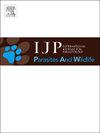利用红狐胃内容物分析追踪多房棘球蚴在其欧洲分布南缘的中间宿主
IF 2.2
3区 医学
Q3 ECOLOGY
International Journal for Parasitology-Parasites and Wildlife
Pub Date : 2025-06-02
DOI:10.1016/j.ijppaw.2025.101095
引用次数: 0
摘要
多房棘球绦虫(Em)是一种带状绦虫,在犬科动物(最终宿主)和田鼠(中间宿主)之间传播。人类在食用鸡蛋后可发生肺泡包虫病(AE)。在意大利,Em存在于Trentino-Alto Adige/ s本文章由计算机程序翻译,如有差异,请以英文原文为准。

Chasing intermediate hosts of Echinococcus multilocularis at the southern edge of its European distribution using red fox stomach content analysis
Echinococcus multilocularis (Em) is a Taeniidae cestode circulating among canids (definitive hosts) and among voles (intermediate hosts). Humans can develop alveolar echinococcosis (AE) following egg ingestion. In Italy, Em is present in red foxes (Vulpes vulpes) from the Trentino-Alto Adige/Südtirol Region, with reports in canids from Liguria (wolf, Canis lupus, and domestic dog, Canis lupus familiaris) and Tuscany (wolf and red fox) Regions. The first autochthonous case of human AE was recently confirmed in the Province of Bolzano. Despite its relevance, the intermediate hosts maintaining the Em life cycle in this area have never been identified.
This study aimed to fill this knowledge gap by collecting ingested rodents from the stomachs of 148 legally culled or found dead foxes across the Province of Bolzano. For 142 prey items, species was ascertained from tissue DNA using a PCR of a 350 bp fragment of cytb mitochondrial gene. Positivity to Em was investigated by RT-PCR and conventional PCR on organ tissues from 97 rodents targeting a 69 bp fragment of cob and a 126 bp fragment of nad2 mitochondrial genes, respectively.
Microtus arvalis was the most common prey rodent in terms of both frequency in foxes (20.8 %; 30/144) and total rodent prey items (81.7 %; 116/142). Other prey species included nine Arvicola amphibius, five Microtus lavernedii, two M. subterraneus, one M. liechtensteini, six Clethrionomys glareolus, one Apodemus flavicollis and two Ap. sylvaticus. Only 3/97 rodents were Em-positive (M. arvalis; 3/85) in two Em-positive red foxes. Prevalence in M. arvalis was estimated at 0.035 (95 % CI: 0.008–0.103). Further research is required to explain why Em distribution is limited to this area in the eastern Italian Alps despite the spatial contiguity to hyperendemic foci.
求助全文
通过发布文献求助,成功后即可免费获取论文全文。
去求助
来源期刊

International Journal for Parasitology-Parasites and Wildlife
Medicine-Infectious Diseases
CiteScore
3.80
自引率
5.60%
发文量
113
审稿时长
45 days
期刊介绍:
The International Journal for Parasitology: Parasites and Wildlife (IJP-PAW) publishes the results of original research on parasites of all wildlife, invertebrate and vertebrate. This includes free-ranging, wild populations, as well as captive wildlife, semi-domesticated species (e.g. reindeer) and farmed populations of recently domesticated or wild-captured species (e.g. cultured fishes). Articles on all aspects of wildlife parasitology are welcomed including taxonomy, biodiversity and distribution, ecology and epidemiology, population biology and host-parasite relationships. The impact of parasites on the health and conservation of wildlife is seen as an important area covered by the journal especially the potential role of environmental factors, for example climate. Also important to the journal is ''one health'' and the nature of interactions between wildlife, people and domestic animals, including disease emergence and zoonoses.
 求助内容:
求助内容: 应助结果提醒方式:
应助结果提醒方式:


